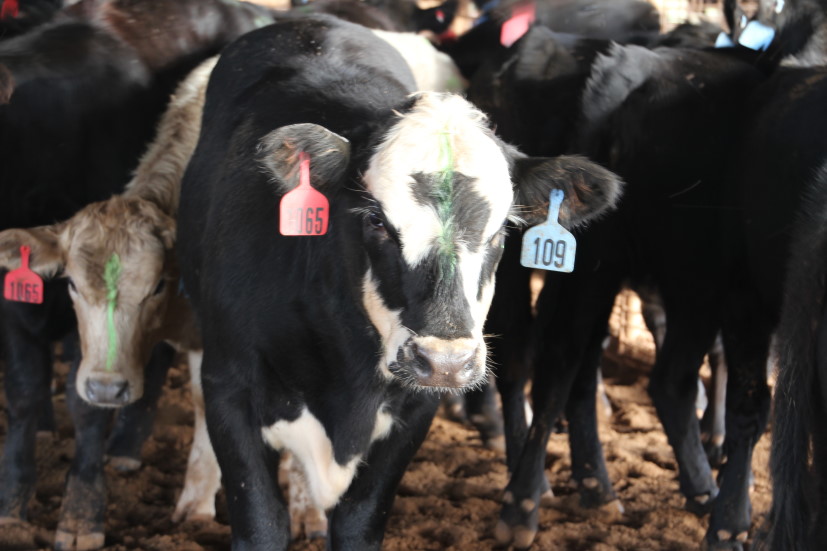
Agricultural News
Derrell Peel Ponders Whether Non Fundamental Feeder Cattle Futures Trade Harms Cash Feeder Cattle Markets or Not
Mon, 02 May 2016 10:26:11 CDT
 Mondays, Dr. Derrell Peel, Oklahoma State University Extension Livestock Marketing Specialist, offers his economic analysis of the beef cattle industry. This analysis is a part of the weekly series known as the "Cow Calf Corner" published electronically by Dr. Peel and Dr. Glenn Selk. Today, Dr. Peel looks at the non fundamental nature of today's Feeder Cattle Futures.
Mondays, Dr. Derrell Peel, Oklahoma State University Extension Livestock Marketing Specialist, offers his economic analysis of the beef cattle industry. This analysis is a part of the weekly series known as the "Cow Calf Corner" published electronically by Dr. Peel and Dr. Glenn Selk. Today, Dr. Peel looks at the non fundamental nature of today's Feeder Cattle Futures.
"A growing chorus of cattle producers are expressing frustration regarding feeder cattle futures markets. For many years, I have defended the value of futures markets and the role of speculators in making those markets possible. However, it is increasingly important to ask and deal with questions and concerns, or the alternative may be undesired.
"Feeder futures have become increasingly volatile in ways that often appear unrelated to market fundamentals. Erratic futures price movements and increased basis volatility makes it difficult or impossible for the industry to use feeder futures for its two primary roles of risk management and price discovery. Producers have historically been quick to blame speculators for unwarranted influence in cattle markets but without speculators there would not be enough liquidity for most agriculturally-based futures markets.
"Since their inception in 1971, feeder futures contracts have suffered from marginal levels of liquidity, which often limited the effectiveness of the contracts. Feeder futures (and especially options) have been thinly traded in the distant contracts making them difficult to use. Liquidity is required for traders to have orders filled quickly, completely and cost effectively. A question is, have changes in recent years have aggravated the problem and threaten the future viability of feeder futures?
"Institutional changes in trading hours and daily price limits are all pieces of the puzzle. Have trading hours become too long for the amount of traders taking positions each hour or even each minute given modern technology? Daily trading limits have been expanded to allow markets to adjust faster and not be hamstrung. While this is necessary in a world of generally increased commodity market volatility and higher than historical price levels, it also allows larger futures price movements when no fundamental reason exists or when a "cooling off" period is warranted. Wider trading limits are not the cause of erratic futures market behavior and focusing on trading limits may be ignoring the underlying cause of volatility.
"A growing proportion of the outside (non-hedging) liquidity in feeder futures is, by many accounts, from sources motivated primarily by portfolio management rather than actually speculating based on feeder cattle market fundamentals. Aided by computers and mechanical trading strategies, this type of activity tends to result in movements into and out of futures markets quickly and violently; resulting in increasing market volatility as underlying liquidity is exhausted. Often this type of trading includes broad-based commodity indexes of energy, precious metals and other commodities and of which feeder futures is a tiny proportion. Yet, if or when large amounts of money is directed at these commodity indexes or directly into feeder futures markets, often for reasons unrelated to cattle markets, feeder futures go along for the ride. Unfortunately, erratic futures markets have a very real impact on actual cash feeder markets with consequences that impact the entire industry and not only for direct users or potential users of the futures market. Just talk to producers or sit at most any cattle auction; it's obvious that participants are watching futures prices, both feeder and live cattle.
"Finding solutions for these problems is, admittedly, a challenge. Futures markets cannot function without outside (speculative) liquidity. However, it is becoming increasingly apparent that they cannot function effectively with high proportions of liquidity that is not market effective. Perceptions are that the industry (feeder cattle producers and feedlots) are increasingly not willing or able to use feeder futures meaning that "non-fundamental" trading is responsible for more and larger price movements. This suggests that feeder cattle futures could be on a path to imploding and completely collapsing. Feeder cattle futures must be a useful and viable tool for the industry or it will not be useful or viable for anyone. In the meantime, erratic futures trading has significant detrimental impacts on cash feeder cattle markets. Increasingly, the tail is wagging the dog.
"What's worse than no feeder cattle futures? The answer may be when we have what appears to be a dysfunctional feeder futures market that is not ignored by enough of the industry and thus messes up actual feeder markets. This is, or is close to, the situation today."
WebReadyTM Powered by WireReady® NSI
Top Agricultural News
More Headlines...




